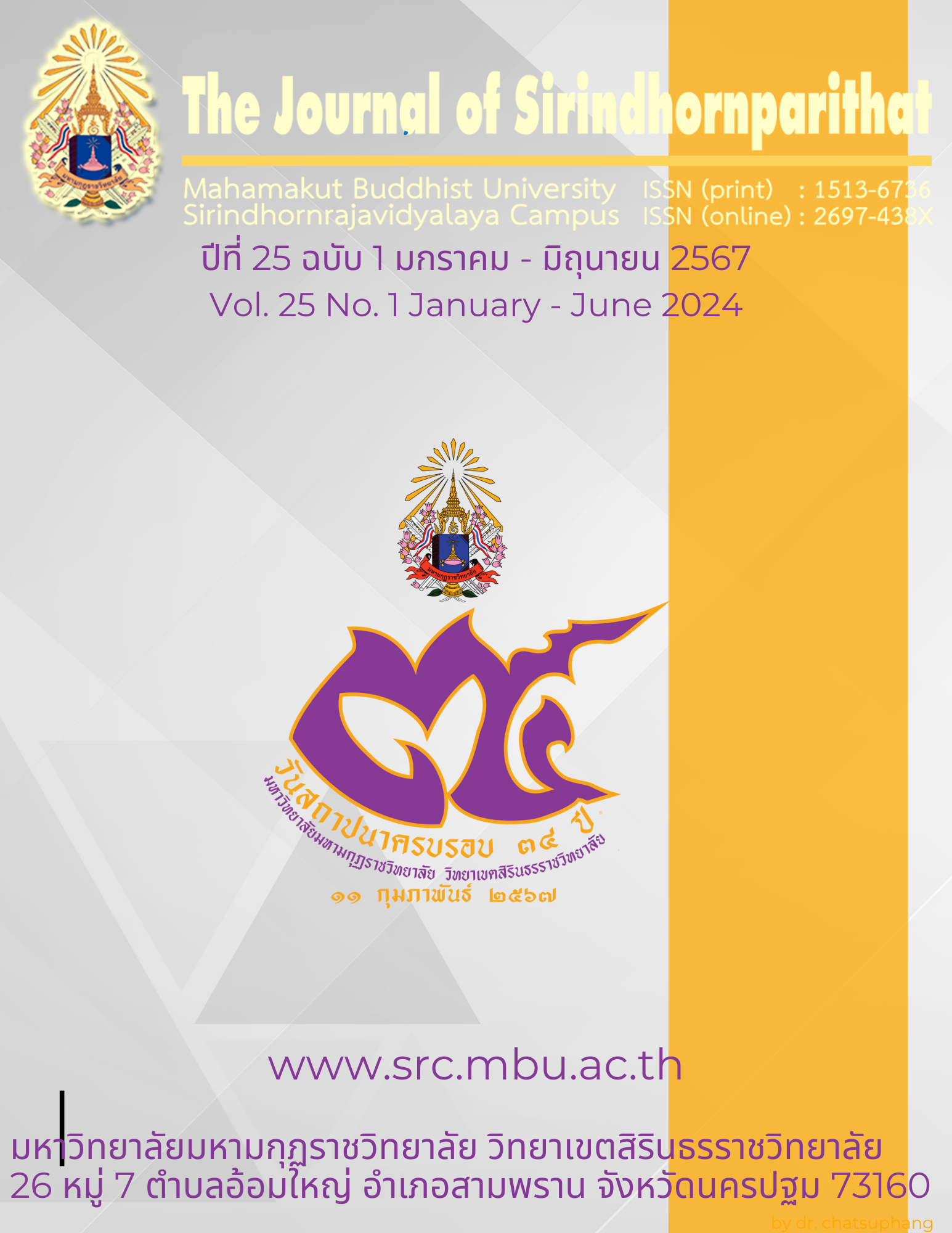The students on using the media of the teacher-monks teaching morality in Wat Srisamranratbumroong School (Cham Pracha-uthit), Omnoi sub-district, Krathum Baen district, Samut Sakhon province
Keywords:
Morality, The Students, Using the Media of The Teacher-Monks TeachingAbstract
The objectives of this thesis are as follows: 1) to study expectations of the students on using the media of the teacher-monks teaching morality in Wat Srisamranratbumroong School (Cham Pracha-uthit), Omnoi sub-district, Krathum Baen district, Samut Sakhon province 2) to compare the expectations of the students on using the media of the teacher-monks teaching morality in Wat Srisamranratbumroong School (Cham Pracha-uthit), Omnoi sub-district, Krathum Baen district, Samut Sakhon province, with different genders, age and class-levels, and 3) to study suggestions and solutions concerning with using the media of the teacher-monks teaching morality in Wat Srisamranratbumroong School (Cham Pracha-uthit), Omnoi sub-district, Krathum Baen district, Samut Sakhon province. The research tool was a questionnaire. The samples used in the research were the 229 of the students studying in Wat Sri Samranratbumroong School sized by the tables of Krejcie´ and Morgan’ and used a simple random for collecting data. The research tool was a questionnaire tested quality and test coefficient alpha = 0.92. The statistics used were frequency, percentage, mean and standard deviation: ANOVA Test. If differences were found, they were tested by means of Scheffe´, and analyzed by a computer.
The results of research were found that 1) The students expected on using the media of the teacher-monks teaching morality in school on a high level in the whole view of 4 aspects. Having considered each aspect, it was found that teaching, using of teaching materials, and management of teaching were on a high level. And evaluation was found that it was on moderate level. 2) The result of this hypothesis testing were found that the students with different personal factors had no difference. And 3) The expectations on using the media of the teacher-monks teaching morality in the school in the whole view of the 4 aspects. Besides, the students had suggestions and solutions concerning with using the media of the teacher-monks teaching morality in the school: 1) teaching - the teacher-monks teaching morality in the school did not follow the steps of the contents of the subject, the teacher-monks teaching morality in the school should follow the steps of the contents of the subject so that they will not confuse 2) using the teaching materials - the teacher-monks teaching morality in the school had a lack of various media to teach, therefore, the teacher-minks teaching morality in the school should provide various media related the contents that they teach before the introduction of the course 3) The management of teaching and learning – the teacher-monks teaching morality in the school had a lack of students’ activities having been divided into different groups in order to the principles of Dhamma, therefore, the teacher-monks teaching in the schools should divide the groups of the students to do the activities according to the principles of the Dhamma and then let them present to the class, and 4) the evaluation – the teacher-monks teaching morality in the schools had a lack of evaluation before teaching, so teacher-monks teaching morality in the schools should evaluate the students before actually teaching.
References
กรมการศาสนา. (2548). คู่มือการดำเนินงานตามโครงการครูพระสอนศีลธรรมในโรงเรียน.กรุงเทพมหานคร : โรงพิมพ์คุรุสภา.
กลุ่มสาระการเรียนรู้สังคมศึกษา ศาสนาและวัฒนธรรม ตามหลักสูตรการศึกษาขั้นพื้นฐาน พุทธศักราช 2544. (2551). การจัดสาระการเรียนรู้พระพุทธศาสนา. พิมพ์ครั้งที่ 5. กรุงเทพมหานคร : จัดพิมพ์โดยธรรมสภา.
กัลยา วานิชย์บัญชา. (2548). สถิติสำหรับงานวิจัย. กรุงเทพมหานคร : ภาควิชาสถิติ คณะพาณิชยศาสตร์และบัญชี จุฬาลงกรณ์มหาวิทยาลัย.
จริยา เนียนเฉลย. (2535). เทคโนโลยีการศึกษา. กรุงเทพมหานคร : ศูนย์สื่อกรุงเทพมหานคร.
ชวลิต ชูกำแพง. (2551). การประเมินการเรียนรู้. กรุงเทพมหานคร : มหาวิทยาลัยมหาสารคาม.
ดำรงค์เดช วิสาโท, พระ (ทองสิมา). (2554). การสอนวิชาพระพุทธศาสนาของครูพระสอนศีลธรรมในมุมมองของนักเรียนโรงเรียนหนองนกไข่ ตำบลหนองนกไข่ อำเภอกระทุ่มแบน จังหวัดสมุทรสาคร. ปริญญานิพนธ์การศึกษามหาบัณฑิต. บัณฑิตวิทยาลัย : มหาวิทยาลัยมหามกุฏราชวิทยาลัย.
นิพนธ์ เทวธมฺโม, พระ (แก้วแหวน). (2551). การประเมินผลการสอนวิชาพระพุทธศาสนาในสถานศึกษาขั้นพื้นฐาน สำนักงานเขตพื้นที่การศึกษา กรุงเทพมหานคร เขต 2”. วิทยานิพนธ์พุทธศาสตรมหาบัณฑิต. บัณฑิตวิทยาลัย : มหาวิทยาลัยมหาจุฬาลงกรณราชวิทยาลัย.
ประสิทธิ์ สังข์สม, พระปลัด. (2546). ความคาดหวังที่มีต่อสาระการเรียนรู้พระพุทธศาสนาของนักเรียน ระดับชั้นมัธยมศึกษาตอนปลาย โรงเรียนนำร่องและโรงเรียนเครือข่ายการใช้หลักสูตรการศึกษาขั้นพื้นฐาน สังกัดกรมสามัญศึกษา จังหวัดนครศรีธรรมราช. วิทยานิพนธ์ศิลปศาสตรมหาบัณฑิต. บัณฑิตวิทยาลัย : มหาวิทยาลัยราชภัฏนครศรีธรรมราช.
พระครูสุนทรธรรมโสภณ (วิเชียร ปญฺญาวุฑฺโฒ). (2545). หลักการสอน. นครปฐม : มหาวิทยาลัยมหามกุฏราชวิทยาลัย วิทยาเขตสิรินธรราชวิทยาลัย ในพระราชูปถัมภ์.
พระธรรมปิฎก (ป.อ. ปยุตฺโต). (2544). พุทธวิธีในการสอน. กรุงเทพมหานคร : โรงพิมพ์ บริษัท สหธรรมิก จำกัด.
พระราชรัตนมงคล (มนตรี ยางธิสาร). (2547). ความคิดเห็นของครูพระสอนศีลธรรมเกี่ยวกับการปฏิบัติงานสอนในโรงเรียนเขตกรุงเทพมหานคร”. วิทยานิพนธ์มหาบัณฑิต. บัณฑิตวิทยาลัย : มหาวิทยาลัยศรีนครินทรวิโรฒ.

Downloads
Published
Issue
Section
License
Copyright (c) 2024 Mahamakut Buddhist University

This work is licensed under a Creative Commons Attribution-NonCommercial-NoDerivatives 4.0 International License.
บทความที่ได้รับการตีพิมพ์เป็นลิขสิทธิ์ของ มหาวิทยาลัยมหามกุฏราชวิทยาลัย วิทยาเขตสิรินธรราชวิทยาลัย
ข้อความที่ปรากฏในบทความแต่ละเรื่องในวารสารวิชาการเล่มนี้เป็นความคิดเห็นส่วนตัวของผู้เขียนแต่ละท่านไม่เกี่ยวข้องกับหาวิทยาลัยมหามกุฏราชวิทยาลัย วิทยาเขตสิรินธรราชวิทยาลัย และคณาจารย์ท่านอื่นๆในมหาวิทยาลัยฯ แต่อย่างใด ความรับผิดชอบองค์ประกอบทั้งหมดของบทความแต่ละเรื่องเป็นของผู้เขียนแต่ละท่าน หากมีความผิดพลาดใดๆ ผู้เขียนแต่ละท่านจะรับผิดชอบบทความของตนเองแต่ผู้เดียว



